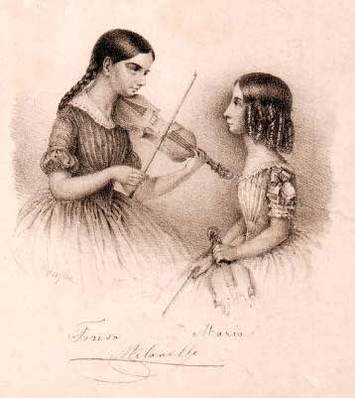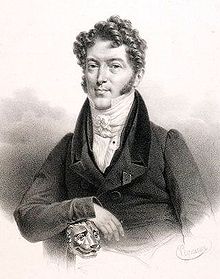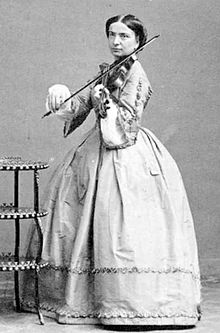By Andy Fein, luthier at Fein Violins
and Joe Peterson
Her debut was a great success, and so her parents put her on a mule and took off to continue her studies in Paris with Charles Philippe Lafont, a student of Kreutzer and Rode. He was very impressed, and took her on tour with him (thus breaking one of the cardinal rules of show biz- never follow a kid or an animal act). She toured all around Europe, playing with Johann Strauss the Elder along the way. She did all of this before she was 12 years old.
After touring all over Europe, she went back to France and started teaching her younger sister Maria, aged 6, the violin. Soon, they began playing duets in public and took off on another tour. Sometime during the sisters' tour, Teresa Milanollo met Charles De Beriot, who took her on as a student in Brussels. He was her final teacher, and taught her the bowing technique of Viotti and Baillot, along with perfect intonation. Teresa would be the only teacher Maria would have, as, at 16, she succumbed to tuberculosis. Teresa was heartbroken! She would play many benefit concerts in her honor.
During the Milanollos' career, they performed not only for European royalty, but also for famous composers such as Liszt, Berlioz, Meyerbeer, and Chopin. The Italian bass virtuoso Domenico Dragonetti liked these two so much that he left them each a violin in his will: He left Teresa a violin made in 1728 by Antonio Stradivari that was played by Paganini, and he left Maria a small sized violin by Francesco Ruggieri. Teresa's father had also purchased a Stradivari made in 1703 for her. The 1728 Strad went on to be played by French violinist Christian Ferras. If you haven't heard him play before, here he is playing Ravel's Tzigane. The small sized Ruggieri was recently sold in a Tarisio Auction.
and Joe Peterson
We often think of the great violin virtuosos of the nineteenth century as being all male. That's far from the truth! There were great female violinists then as much as there are today. We bring you the life of the Milanollo sisters. Great violinists of the late nineteenth century.
Around the time Paganini went to play for the angels or the devil (depending on your view of his life), there were two Italian sisters from the Piedmont region named Teresa and Maria Milanollo, who were also very, very, very good at the violin. Sometime around 1840, Teresa, the elder of the two, reportedly heard a violinist at church when she was 4 and decided then and there that she wanted to be a violinist. Her father, a manufacturer of fabric making machines and a luthier, made her a violin of white wood, and she began studying in Savigliano. Soon, she made her debut in Turin.
19th century Turin
Brussels, Belgium
ex-Milanollo Ruggeri
Teresa Milanollo
1728 Milanollo Stradivarius
1728 Milanollo Stradivarius
Teresa gave her last public performance when she was only 29 years old, and later that day, she married a future general, Theodore Parmentier. She kept the 1728 Milanollo Stradivarius until her death in 1904.
The Milanollo sisters were certainly not the first great female violinists, but they did their part paving the way for so many other great women violinists- Ida Haendel, Erica Morini, Anne-Sophie Mutter, Anne Akiko Meyers, Midori, Rachel Barton Pine, Hilary Hahn, Lara St. John, and many, many more. Know any other great sister acts in the string world? Let us know.
Watch a video of Corey Cerovsek
playing the Milanollo Stradivarius and talking about how wonderful playing it is.
The Milanollo sisters were certainly not the first great female violinists, but they did their part paving the way for so many other great women violinists- Ida Haendel, Erica Morini, Anne-Sophie Mutter, Anne Akiko Meyers, Midori, Rachel Barton Pine, Hilary Hahn, Lara St. John, and many, many more. Know any other great sister acts in the string world? Let us know.
Watch a video of Corey Cerovsek
playing the Milanollo Stradivarius and talking about how wonderful playing it is.
Are you a violinist or interested in becoming one? Take a look at our Fine Violins!







I was treated to a practice session by Mssr. Cerovsek at the house of a friend of mine over the holidays. I have been blessed by happenstance in that unexpected event.
ReplyDelete